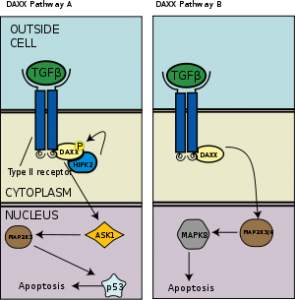| DAXX pathway in TGF beta signaling (Photo credit: Wikipedia) |
This is a critical exploration of the potential utility (or otherwise) of Platelet Rich Plasma (PRP) in cosmetic treatments. Please read Part 1 & 2.
| Transforming growth factor beta (TGF-β) is a secreted protein that controls proliferation, cellular differentiation, and other functions in most cells. http://en.wikipedia.org/wiki/TGFbeta (Photo credit: Wikipedia) |
Coming to Transforming growth factor beta, TGF-β is a protein that has an inhibitory control over cellular proliferation and differentiation especially epithelial cells. TGF-β induces apoptosis in many cell types through the SMAD and DAXX pathways. It blocks advance through the G1 phase of the cell cycle. Higher concentrations of TGF-β are found in Alzheimer’s Disease and Keratoconus. In short it has an effect opposite to that of PDGF.
Fibroblast growth factor (FGF) is a “promiscuous” growth factor with multiple actions on multiple cell types. In mature tissues/systems it is mostly involved in angiogenesis, keratinocyte organization, and wound healing processes. Its two variants FGF1 and FGF2 are more potent angiogenic factors than vascular endothelial growth factor (VEGF) or platelet-derived growth factor(PDGF) and can give rise to granulation tissue. FGF can bind heparan sulfates in extracellular matrix and could have a paracrine effect that is very important in PRP.
Read all articles in this series on PRP.

- Machine learning-based BOTOX API - April 11, 2023
- Skinmesh: Machine learning for facial analysis - November 10, 2020
- Free Dermatology EMR for Machine Learning and Artificial Intelligence - January 2, 2020





Leave a Reply